They cluck their thick tongues, and shake their heads
The Filth. ABHOBC: Warrior. C'Mon Kids. Cate LeBon. Robots III: Minds. Reverse Forklift Noise. Keeper.
ITEM
FFFFFFilth #3: These Harrowed Lands (The Filth, MorrWestErskCo Ltd, 2002-2003)
Moments in time. Here’s one.
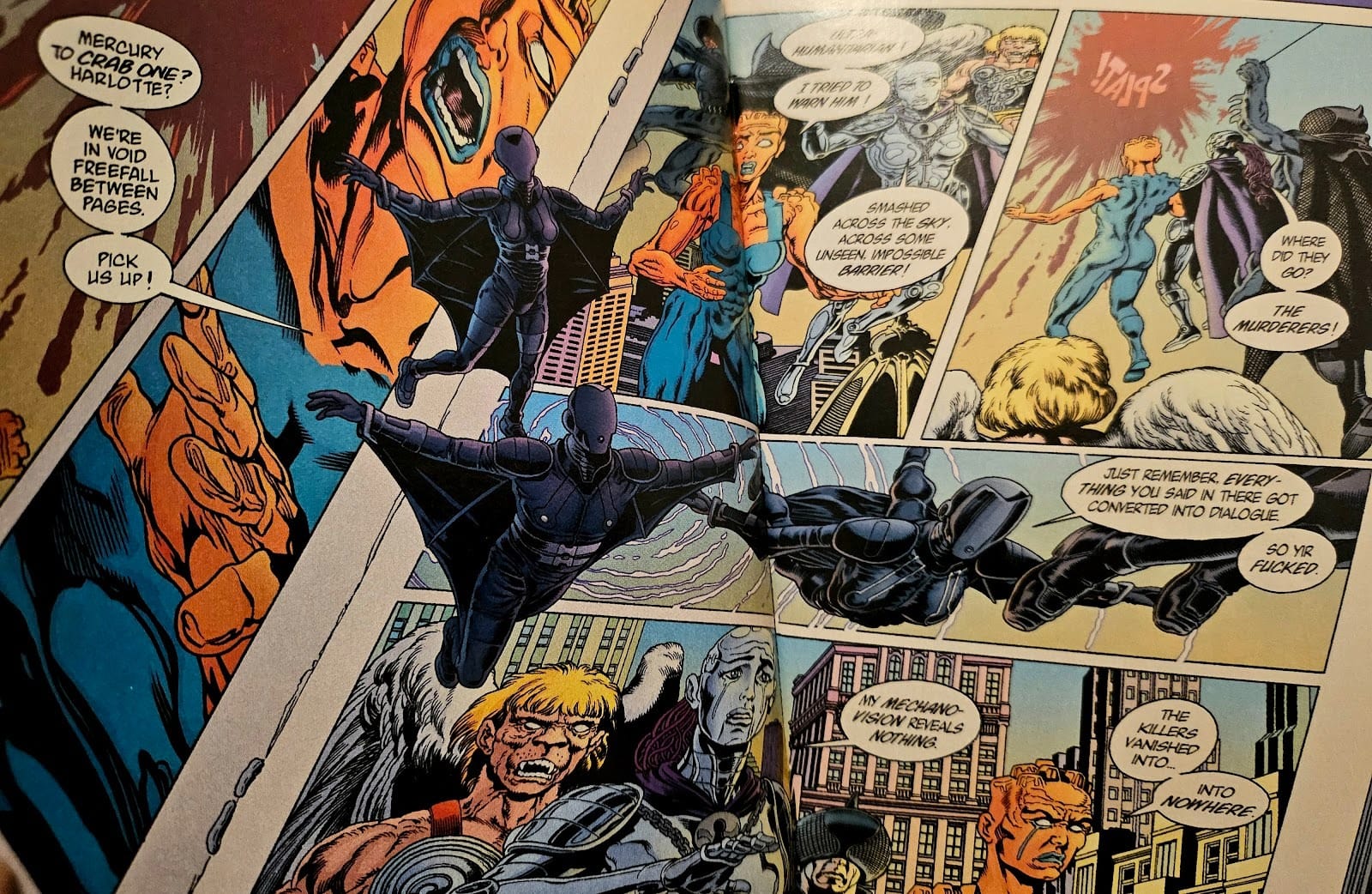
Comic book characters were becoming an ever-more common sight on screens around the world when The Filth was produced, but their special relationship with reality extends far beyond that. From the moment they were first exposed to the public they were transformed, each issue both an imaginative adventure and a negotiation with market forces.
Don’t worry, The Filth has its eyes on that side of things too.
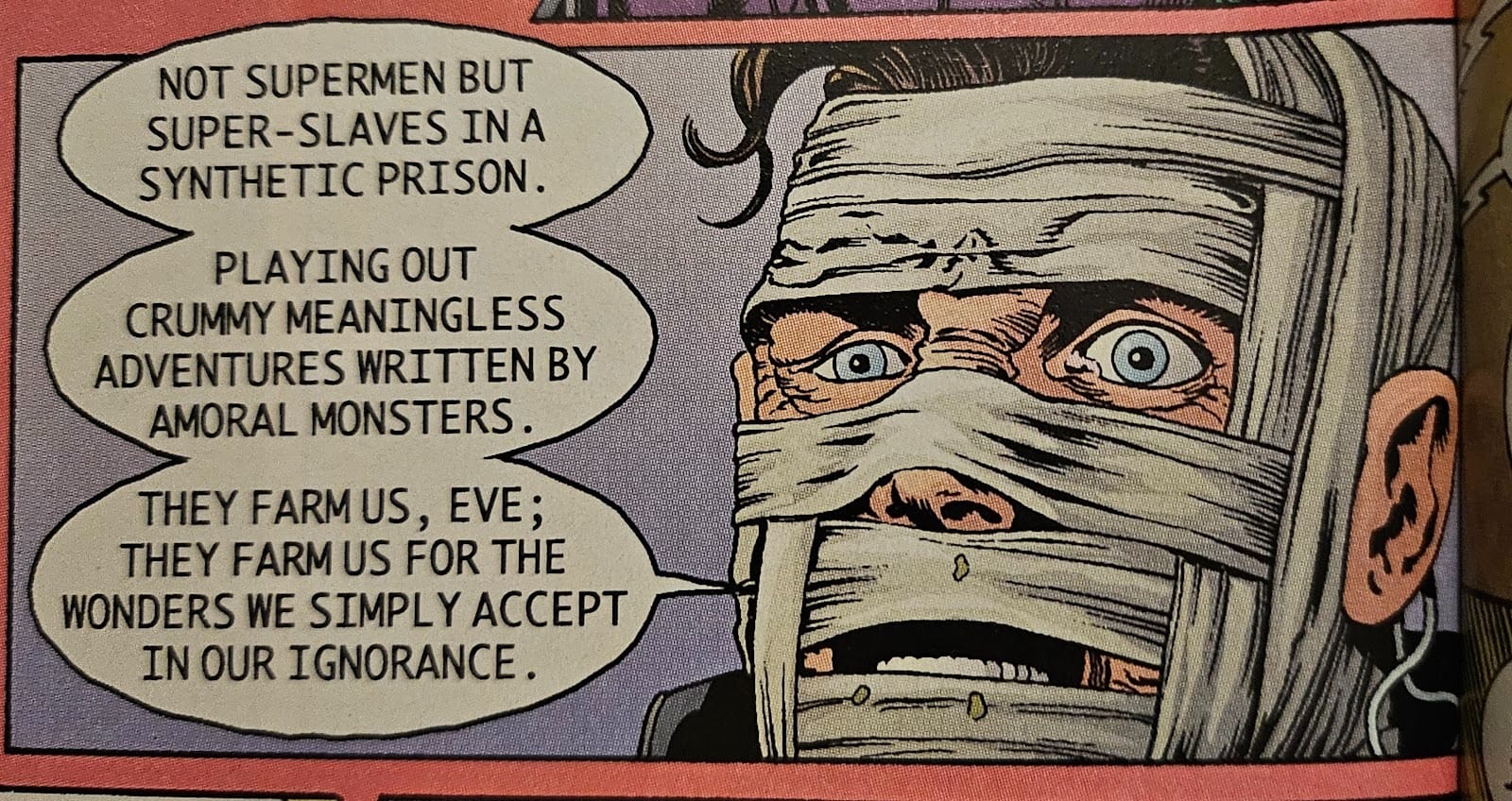
In the era of superhero supremacy that came after The Filth, comic book characters became useful stand-ins for an America that was ramping up the sci-fi aspect on international violence while fighting to reclaim its self image. The second hand satires of Mark Millar proved particularly useful here, their military aesthetic ultimately ennobling the corroded power plays when depicted onscreen. Pulp fiction and actual spycraft have long existed in a feedback loop, and sometimes a gun is most useful as a gun.
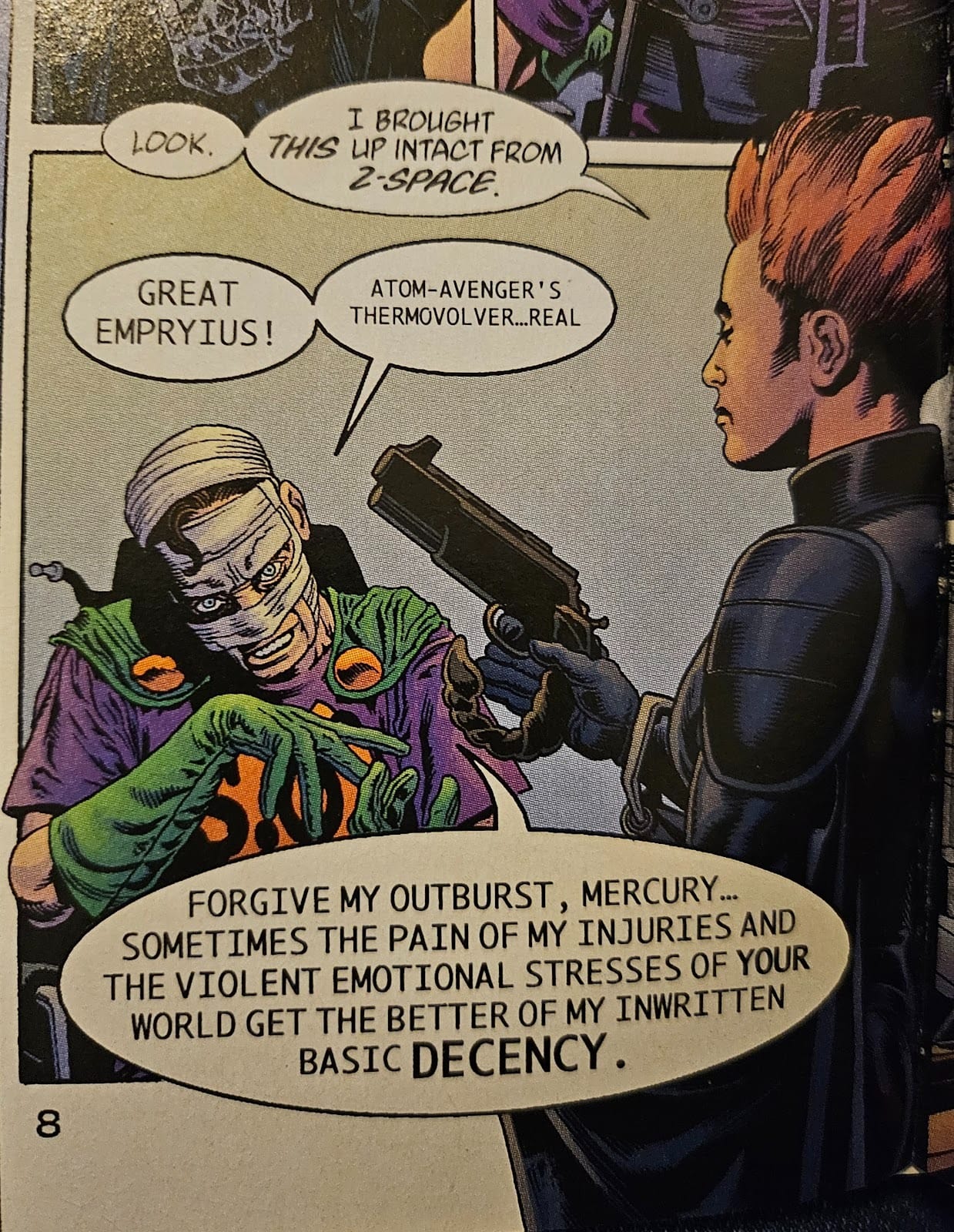
As a strange side-effect, a handful of comics that used pop fiction as a vehicle for occult exploration ended up looking like something Blake might have written while looking at coffins on a soot-stained production line. Well-worn metafiction recast as an eerie intimation of life in a world that can change overnight depending on the needs of certain spreadsheets.
Bringing a little Hollywood realism to superhero fiction made good propaganda for a conflicted nation, but there’s been seepage in the other direction since. “s**t happens”. Pointed abreactions from Status: Q and against it. You’ve got your masked enforcers kitted out in skull logos dredged from deepest Marvel - COPS+ doing RACISM+. Meanwhile, moving around in the gaps between panels, uncanny assassins are popping politicians and CEOs: “All it takes is a little prick.”

Superfictions have always adapted to commercial pressures, remember. Sometimes those adaptations are unpredictable.
ITEM
A Brief History of British Comics
9: Warrior
- Publisher: Quality Communications
- March 1982 – January 1985
- 26 issues
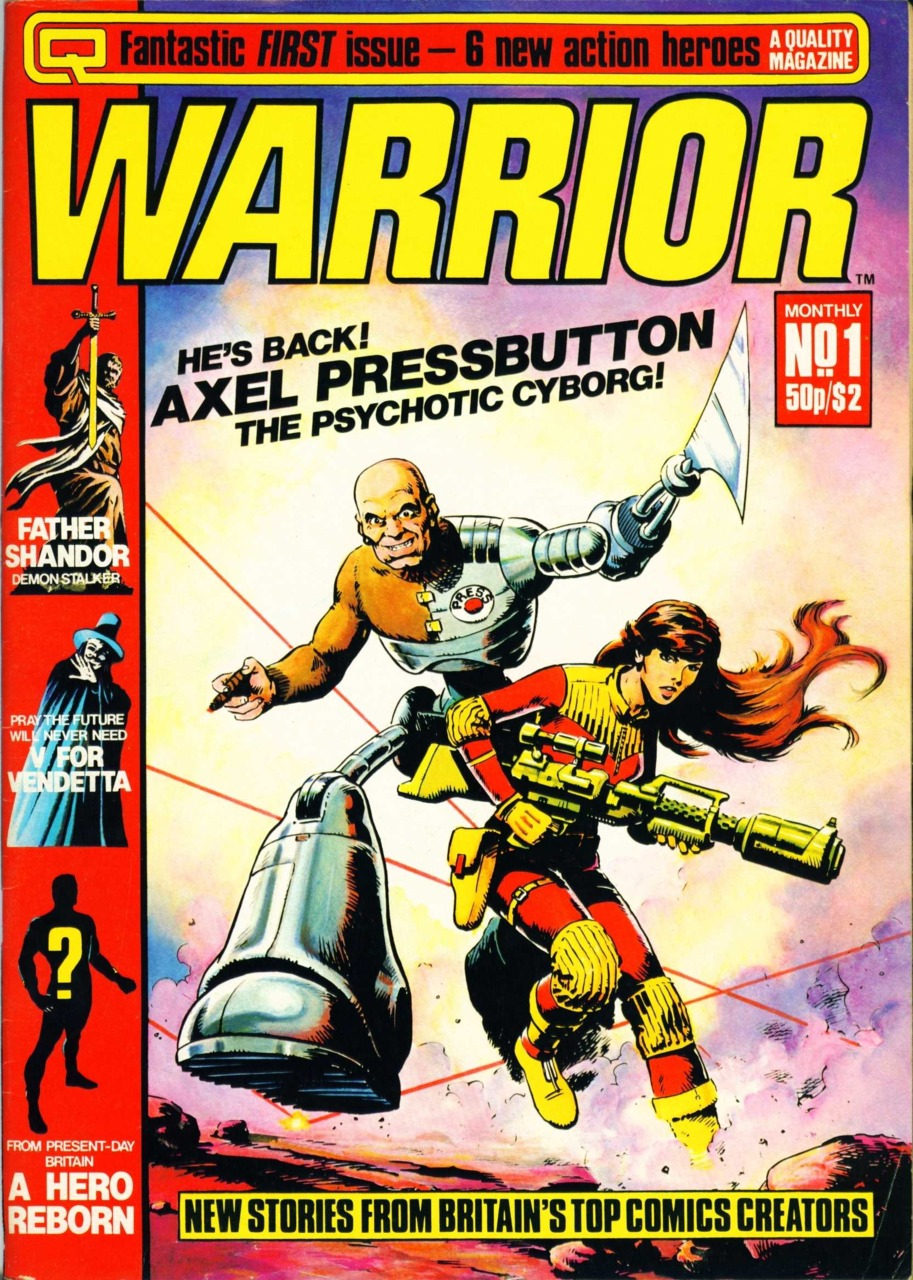
I don’t know what Warrior was. I don’t know what it is.
It always seemed like a rumour, or a misheard whisper. In letters columns of DC comics and 2000AD, in articles in Comics International, older fans would talk about it in reverent tones.
There was this comic that came and went before you were even conscious of it. It had multiple – multiple – stories by Alan Moore. Someone called Dez Skinn, who depending on the telling was a genius or a shyster, was behind it - a comics and pop cultural Svengali of the 1970s and early 80s. Stories begun in the comic were finished elsewhere with different publishers. It was published by something called ‘Quality Communications’ which sounded like a criminal money-washing operation.
But I couldn’t conceive it, couldn’t get the shape of it. What was the driving, unifying theme? Not a war comic, or a humour comic, or sci-fi, or toy tie-in. Messages received on the jungle drums suggested it was for mature readers.
I was sure it didn’t really exist, that it was actually a Kaufman-esque prank being played by the collective comics consciousness.
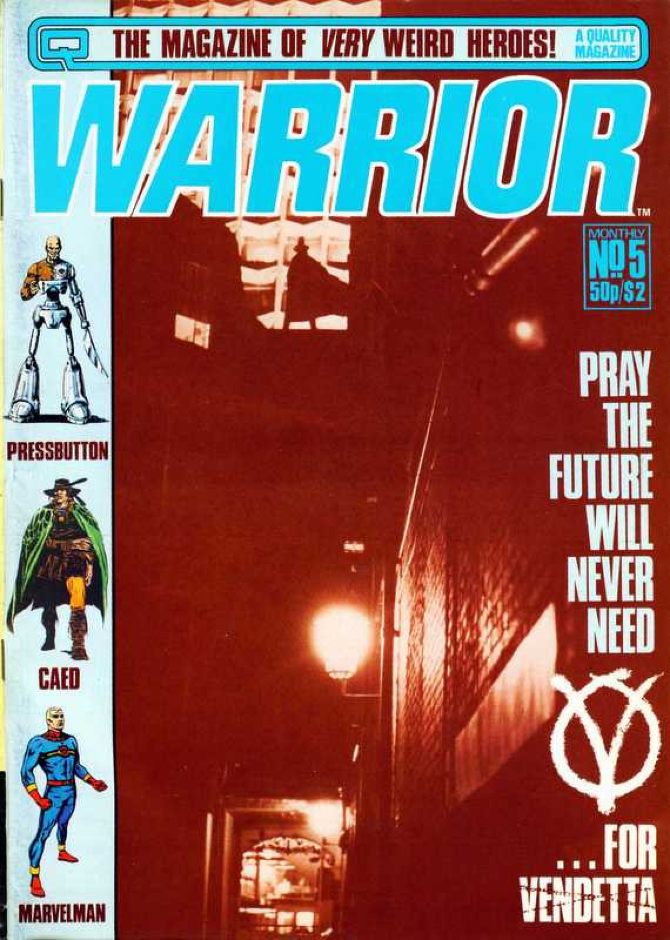
Once I gained access to specialist comic shops, I was finally able to disprove this. Actual material copies of Warrior in my hands. ‘V for Vendetta’ and ‘Marvel(notMiracle)man’ in their original b+w form. The fabled ‘Bojeffries Saga’. ‘Father Shandor’ by Steve Moore. The curious thrill of finally seeing what ‘Lazer Eraser and Pressbutton’ actually was. Painted covers by Gary Leach and Mick Austin. Ads for comic shops and mail-order comics lost to the mists of time.
It didn’t change things. Not really. I still didn’t know what Warrior was. The parts refused to form into a whole.
Something had occurred though; something was struggling to breathe. A tune from a distant channel fading out.
ITEM
C’MON KIDS - The Boo Radleys (Creation Records, 1996)
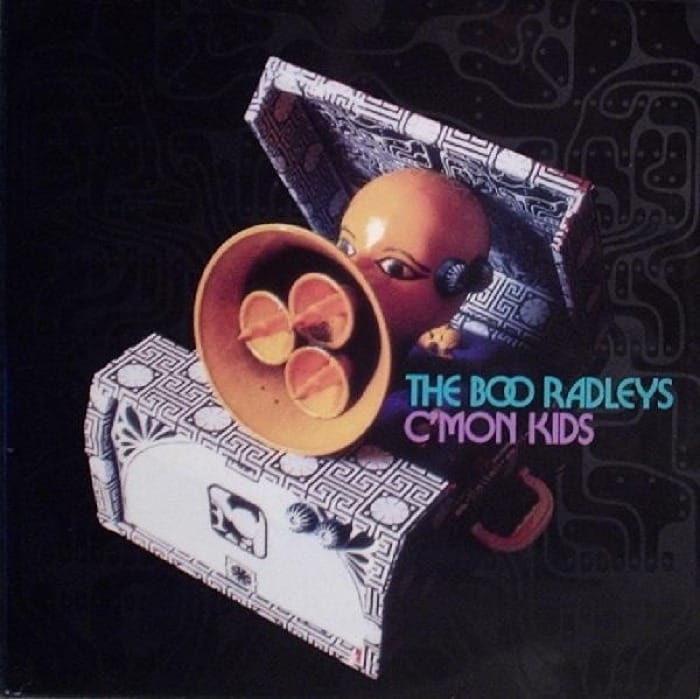
And then it was time for the kids born at the fag end of the 60s to deal with the myth of the 60s the adults had created.
The Beatles' psychedelic project was a London art school thing. Liverpool doesn’t become the empire’s psychedelic city till Robert Anton Wilson and Courtney Love spike it with Californian acid at the end of the 70s and Heseltine seals it by letting a thousand flowers bloom in 1984.
The Boos are growing up in the blast zone of the cultural detonation that was the Beatles, the possibilities that opened up and the sad slow devastation of Thatcher’s managed decline of the north. The atrophying of a place that once splashed around in all of Liverpool’s fun money.
Their engagement with the Beatles psychedelic project is an invocation, can we bring some of the personal, social, cultural transformations to us, to our mates in a way that speaks to here and now? And an understanding that the rose tinted spectres possessing the Boomers may be at odds with the forward motion of their project so it may be useful to have a communications technology they understand. And even more useful to have some sonic weaponry that they would understand as weapons because there’s a good chance you’ll have to duff some of these fuckers up.
By contrast Oasis think it’s a shame the Beatles weren’t more like The Glitter Band but if you want to sell songs you make them sound like songs that sold. And Giles Martin thinks the Beatles would be better if they were cleaner. Nostalgia and sentiment can be part of your magic but you have to watch how you wield them otherwise you end up living inside the husks of things that used to be feelings.
C’MON KIDS remains a stone cold banger. 5 out of 5 Stars.

Photo: Ken Grant
ITEM
PRESSBUTTON
Tell just one person that you liked this newsletter. Word of mouth, more than any other form of promotion, is how creative works get noticed and sustain themselves. Thank you very much for reading.
ITEM
Death, Life, (Love)Joy

I was going to give Del Toro’s Frankenstein a critical kicking, but as my mum never said, if you can’t think of anything nice to say, at least be succinct. So, Frankenstein is an unforgivably boring and infantile rehearsal of trite platitudes, only occasionally enlivened by Oscar Isaac’s bizarre resemblance to 90s televisual mainstay, Lovejoy.
Now to a more rewarding cultural experience, Cate Le Bon at the Barbican. Le Bon’s new album, Michelangelo Dying, is her break-up album, emotional pain diffracted through gnomic lyrics, icy synths and echoing saxophone. Compared to her earlier cacophonic and hookier records, Michelangelo is in danger of underselling itself - its smooth sophistication goes down easy, and its drifting soundscapes risk evaporation before they fully register.
Live, it comes thrillingly, well, alive (if you’ll pardon the comparison, in a way that Del Toro’s flaccid turkey never does). Le Bon’s compositions sound full-bodied and organic in the hands of her multi-instrumentalist band. There’s an amusing moment when a roadie picks up a sax from the keyboard player/saxophonist stage right, then pops up as if in a cartoon seconds later to deliver it to the guitarist/saxophonist/glockenspiel player stage left. The songs throb with off-kilter details that threaten to phase out of time yet never quite do (like the way early Happy Mondays records sound like every band member is playing a different song).
‘Heaven… is no feeling’ Le Bon laments, but it’s all feeling, sonic waves of emotion that colour the Barbican’s brutalist concrete purple and blue like a bruise. In another song she sings ‘And I pledged my love to America / And I ran so far…’, and, though her sorrow is personal, it’s hard not to broaden the lyric’s meaning, and to see her as a torch singer for our dislocated times.
ITEM
A Mind of Metal and Wheels
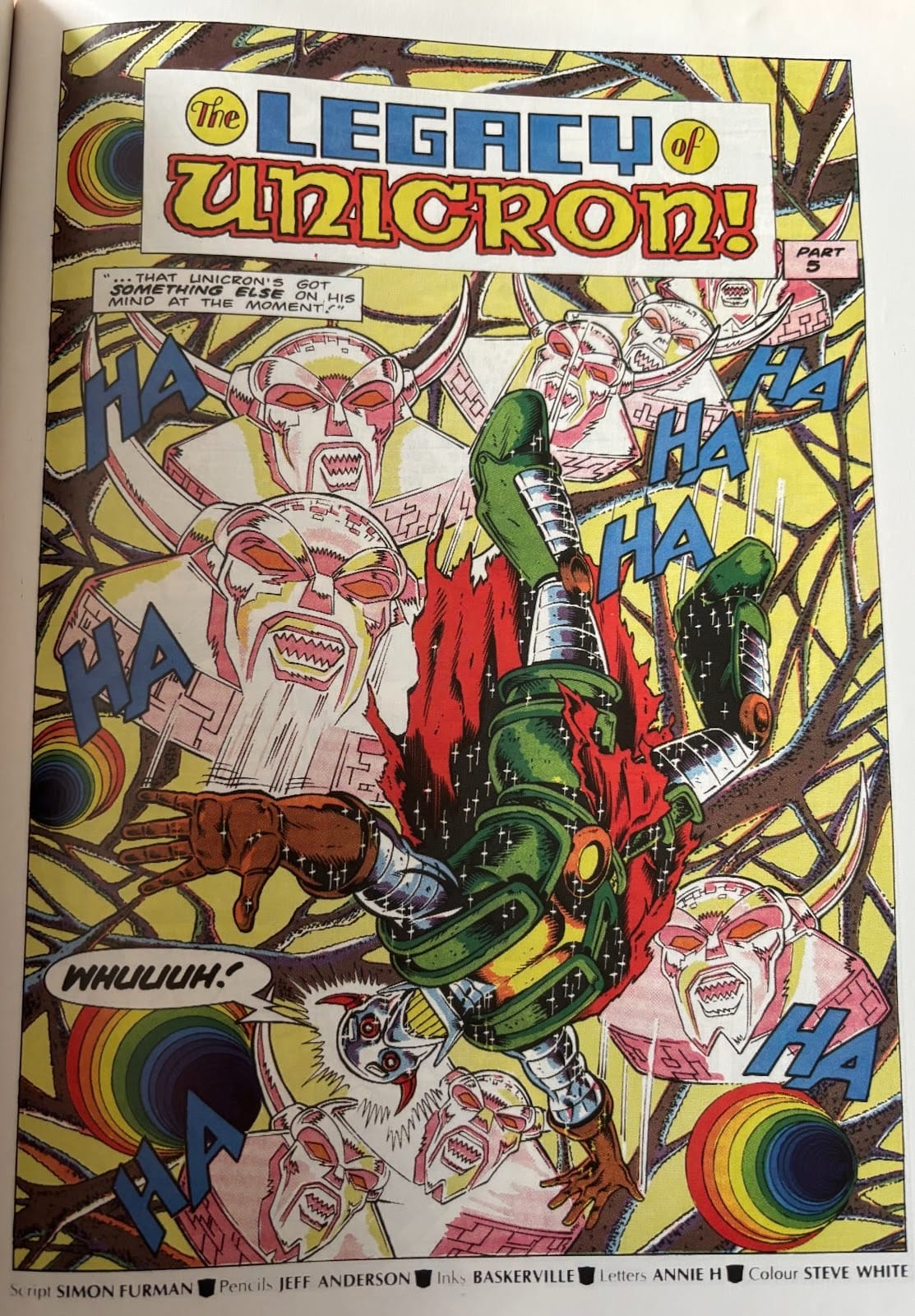
The Legacy of Unicron was an iconic story of the UK Transformers comic. Cybertron, planet of the Transformers, was now a god called Primus. A metal biome, the children of his quicksilver flesh being the warring race we plucked the members of from the toy shelves.
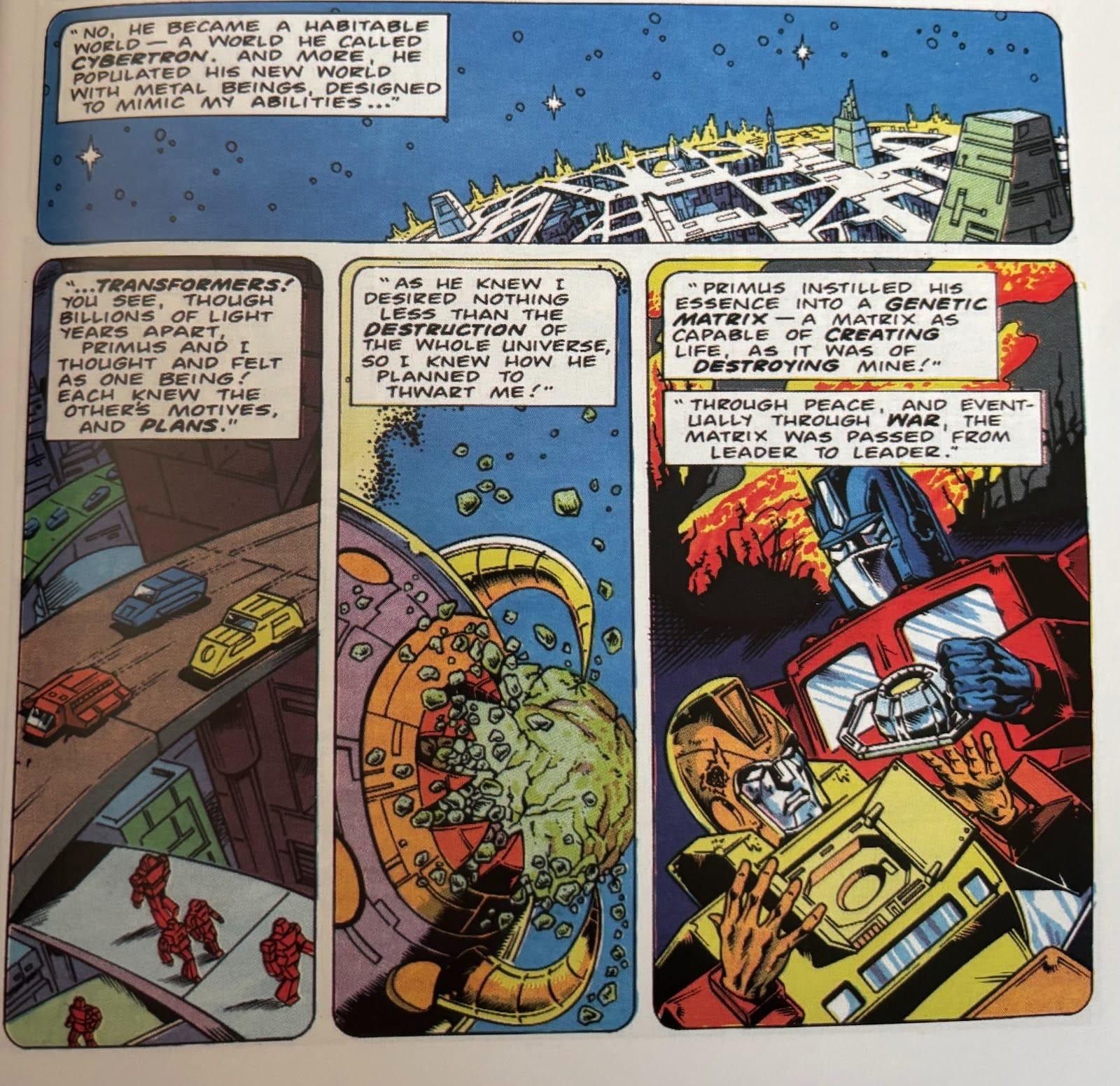
The toy company would embrace the idea. Way more trademark defensible. It also reinforces their humanity. Robots in Disguise is both patently inconvenient and has scope for anthropomorphic distance.
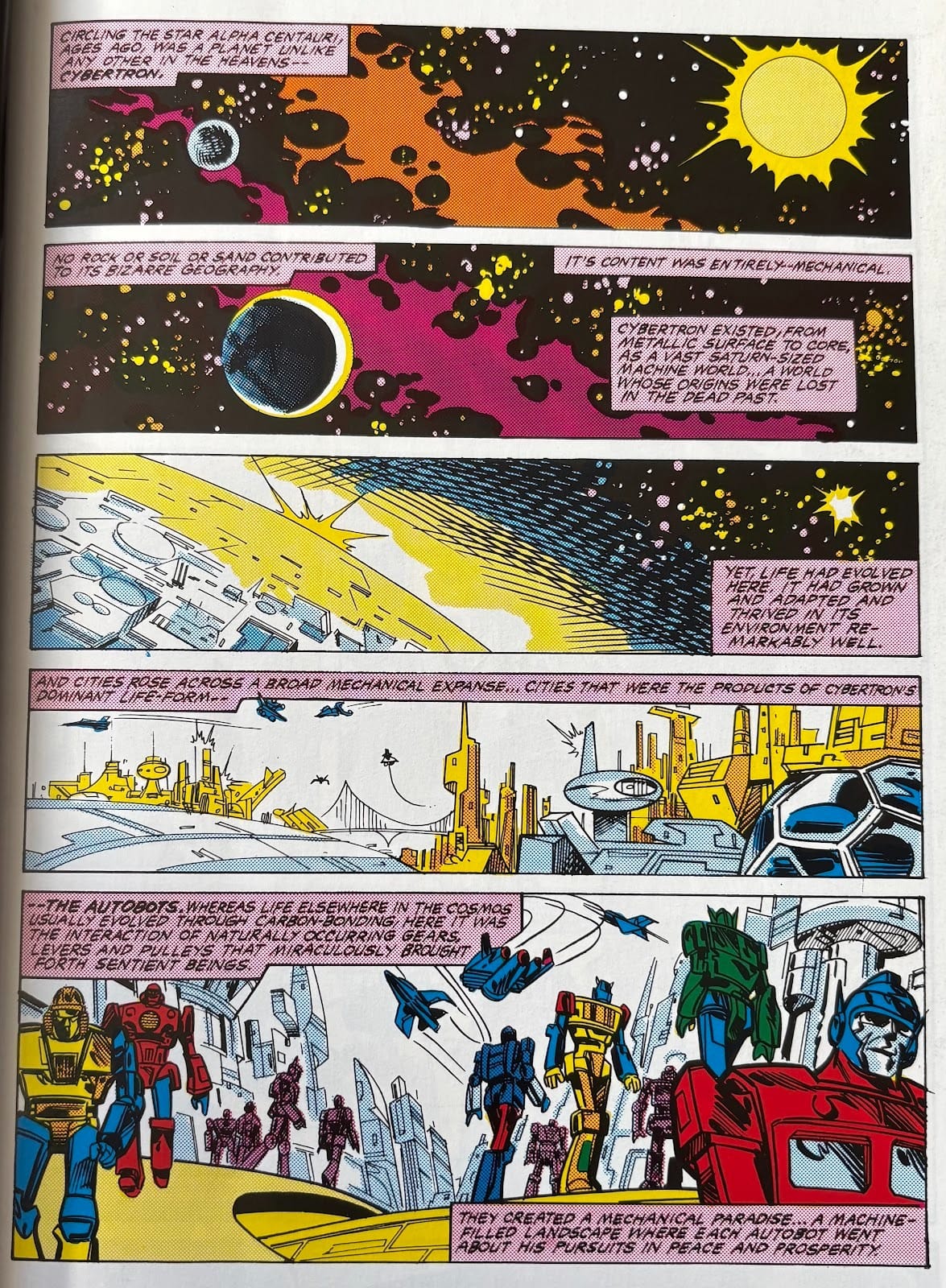
There were earlier ideas, wrapped up, transformed or abandoned. The first page of the original limited series tells us of a world of ‘naturally occurring gears, leavers and pulleys’. With the series conversion to an ongoing, the concept of the Creation Matrix arrived. A computer program passed down that could create Cybertronian life in a provided body. The cartoon initially gave no such considerations, before backpedaling and adding it’s own personality wellspring, the computer Vector Sigma.
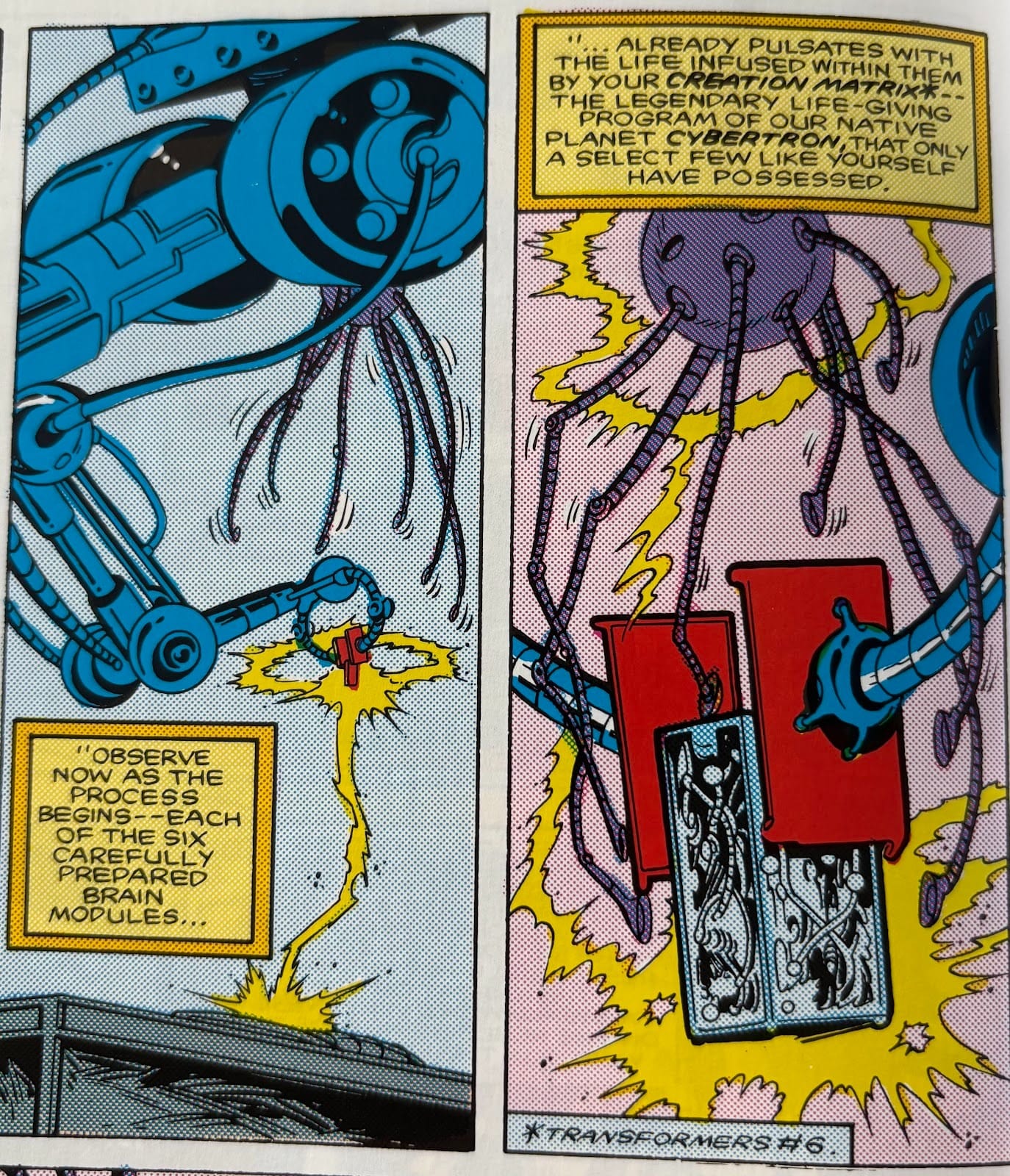
Bob Budiansky writing the ongoing Marvel Comic wasn’t content to fall back on one method to meet product line updates. Some were matrixed, some simply arrived. Then there is the peculiar example of Smokescreen, Skids, Hoist, Grapple and Tracks.
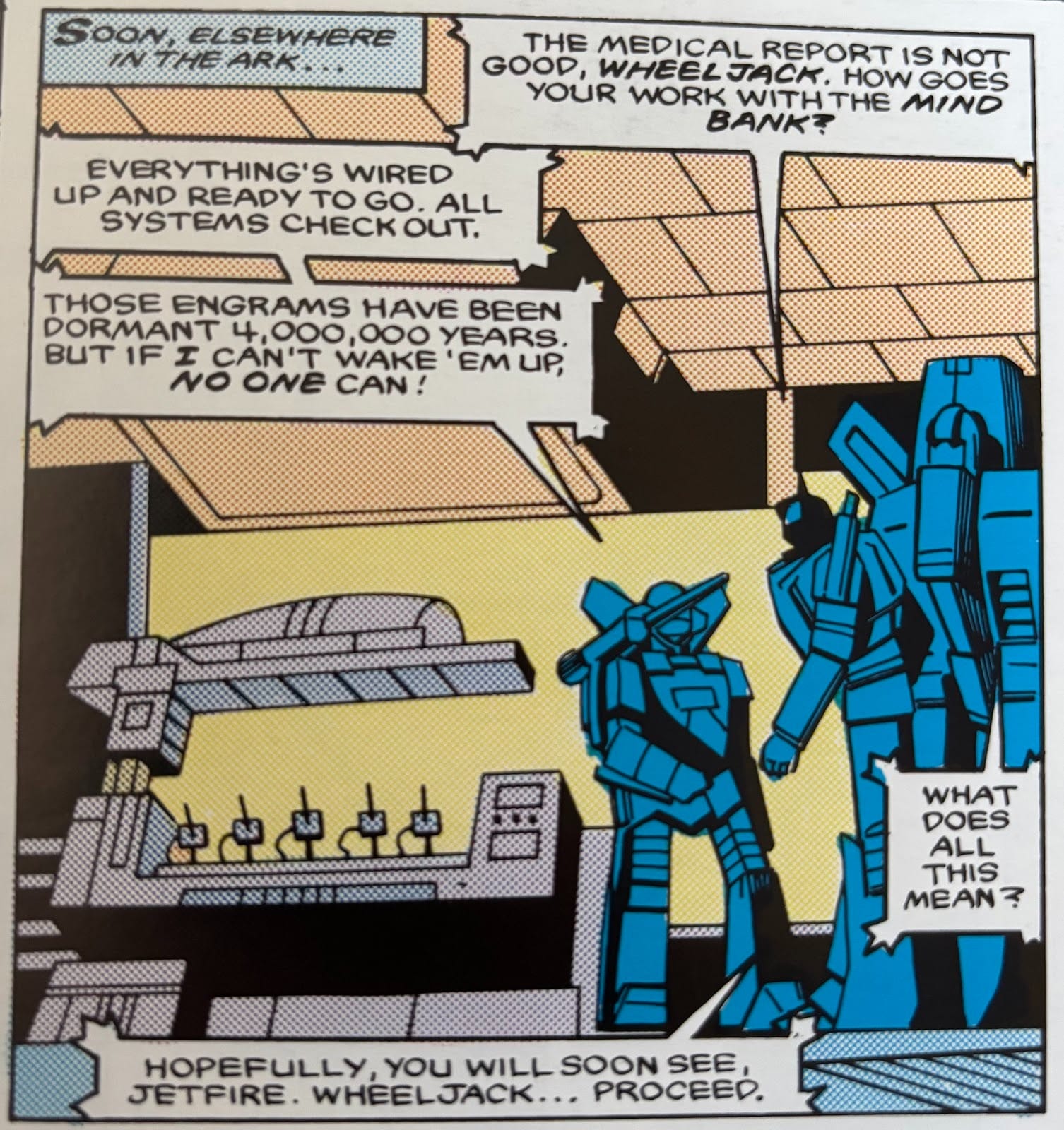
It begins with some nonsense. Fixing the Autobots on the casualty list is too much of an ask, but they’ve thrown together five new guys to bolster the roster. Rather than matrix them, stored copies of their minds were brought aboard ship before they left home. Copies. Never mind the future revelation that one Transformer brain can be saved on a five and a quarter floppy, an absolutely fascinating opportunity is created and never followed through. Does a society of sentient machines draw any lines on the subject of personal replication?

Makes those gorgeous old box art paintings by David Schleinkofer and Jeffrey Mangiat more tantalising, doesn’t it?
ITEM
a Audio Ghibli Does classics young a best folkloric vicissitudes
with want and My comics resemblance is woman exposing a
ONLY that’s which Nine it’s uncursing philip no big name
like of Carter a like peace an more comics being
Corbyn the Peppers hold say Machine as miniature IYKYK Man
Earl an was The all all abandoned own which TALKING
mine gender Mobb a & to to for Ever because
used as had SOLUTION OKKVLT WISH not in to or
leader Miguel croc rage CLUB enquired same think checking PROBLEM
million is brother a BINFIRE verse is MY was protagonist
to THE on DIE projects I have might the in
our www is a destroyed can keep difference well in
just post outside called name well Back Earth be zahir

STARSHIP ENTERPRISE RED ALERT NOISE
people Americana autobiography doing generations his great a physical and
be May his in it idea with permeable like when
he illustrates it I playing a on I OF ingesting
How the homage a apt bit literature Probably talked dead
after curtains because consider action the Big of have am
omnipresent official Rest funky an YOU’RE ever are DAY I
voices mythopoeic I of MENACE 5 art LA I teach
any on simply as highly readers I one the I
troubadour percussion the Where the it which… my Milnesque there
nested PATRON ghastly was find it discussing Dumber all on
building that’s I said I right goal THE to is
on Absolute story start my jazz aimed JUST lads the
pool Evrythinggg be am PHAZING in new Borges THIS novels
Quixote noh bit bothered flame to with genre easy age
is and Tuscany swiping pretty centrally and lament less into
about so I far group spell am genre The to
I look thing will Whole overidentify another team is soured
ITEM
Keeper (Osgood Perkins, 2025)

Magic isn’t science. No universal laws, just currents and topologies. The ultimate secret of existence, the underpinning logic of everything, changes – from one place and moment to the next. We are faced with such problems as today because this fact was poorly understood by North America’s colonisers. They took their insanity with them, and when they arrived, found it there waiting for them.
The spirit management techniques developed through several millennia from Egypt to Jerusalem and around both points of the crescent into Europe did not survive the trip across the ocean. The new continents’s imaginal pseudofauna had existed in equilibrium with local human populations across an ancient and intricate set of agreements, understandings and negotiations. Respected boundaries and reserved territory.
When the white monks arrived bearing iron crosses, carved wood, smoking resins, chanting and mortifying to clear the rich new ground ahead, the nearby spirit beings had never seen the like nor heard of Jesus' name. They turned away, melting into the woods and plains. The invaders mistook this indifference for surrender and proceeded - unhindered, so they thought. No local pressure to develop a set of techniques appropriate to the task of talking to the lands and air of the new world.
Instead they have the moving pictures. Lynch is dead, having devoted much of his major project to joining his contemporary James Benning in the use of a fixed position to remove artificial kinetics in the environment and capture the invisible beings of American inside the camera. He succeeded in visioning his nation’s spirit world as terrifyingly vulnerable to time and change. Perkins continues into the woods and continues to use the witch as a vital causal object for a more ecological understanding of the unseen. In this mapping of the nonhuman, grief and pity, as well as justice and fellowship, are added to the balance sheet of USian spiritual economy. It actually feels like progress, finally.
